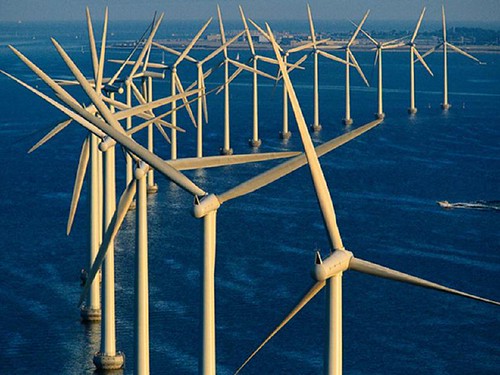Archive for the 'Business' Category
Combined heat and power units
Distributed, private, co-generation is almost certainly part of the solution as we move toward energy independence and reduced emissions. As reported by News.com, Climate Energy, a small Massachusetts company has put a micro-sized combined heat and power unit for homes on the market.
Combined heat and power units are nothing new, they’ve been in use for many years in manufacturing and large, multi-building developments. What makes this entry different is that it is a straight replacement for furnances and supplements the installation with power production of 1.2 kilowatts, or potentially up to 720 kilowatt hours per month (while heat is in use.) To make this personal, in our household we used just over 800 kilowatt hours in January – that would nearly eliminate our power bill taking some $150 in charges out of the equation.
However, this is still a fossil fuel unit powered by natural gas and the $13,500 cost takes around 90 months of heating to break even at our consumption level. It’s a step in the right direction, but there is clearly more room for improvement. Thanks Scott for passing this along.
If you liked this entry, Digg It!
Technorati Tags: Energy | Combined Heat Power | Micro Generation
Ecologically sound network hosting
A former Sun colleague, Jon Greaves, sent me this article a few days ago:
Norfolk Wildlife Trust now has an environmentally friendly
website, after a move this week to solar powered hosting.
Athenaeum who run EcologicalHosting.com are the only UK
based company to have an entire hosting infrastructure
powered from renewable energy sources, making it
low-impact on the environment.Their main hosting is housed in a data centre in California.
Electricity from 120 solar panels capable of generating up
to 60 kilowatts of electricity per day provides all the power
for data centre offices, air conditioners and all computer
equipment.By choosing to host their website with them, NWT is making
a commitment to the environment to protect the future.
Normal data centres obtain their main power from the local
grid supply, using up very large amounts of electricity that
has been generated from non-renewable sources such as coal,
gas or nuclear power stations. Solar hosting plays its part to
help prevent global warming, and so helps to preserve the
natural habitat of animals around the world.Director of Athenaeum Jamie Simpson commented:
‘EcologicalHosting.com welcomes Norfolk Wildlife Trust to
our solar powered Internet service. Along with our other
clients they are showing the world that they care about the
environment and also making a statement that many
traditionally power hungry services like web hosting do
have viable environmentally friendly alternatives available.’Director of Norfolk Wildlife Trust Brendan Joyce commented:
‘We are delighted to move our website to
EcologicalHosting.com, as it is another way of reducing
our impact on the environment. Our website has plenty
of information on wildlife and caring for the environment,
and now our website hosting matches our green philosophy.”
I found this fascinating and believe we’ll see more of this type of company. Power consumption is one of the largest expenses for hosting providers and when they can tap into renewables where the fuel is free, there’s a real competitive advantage to be had over the long haul. Another opportunity I see clearly is harvesting the tens of millions of btus that are exhausted from data centers. It’s not yet clear what the 20-25C resource is good for, but the person or persons who crack that nut will be very rich…
If you liked this entry, Digg It!
Technorati Tags: Eco Hosting | Renewable Energy | Solar
Suicide by Coal
According to the American Heritage Dictionary, a suicidal act is one that is “dangerous to oneself or to one’s interests; self-destructive or ruinous.” By this standard, the coal boom that is currently sweeping America is the atmospheric equivalent of a swan dive off a very tall building. At precisely the moment that scientists have reached a consensus that we need to drastically cut climate-warming pollution, the electric-power industry is racing to build more than 150 new coal plants across the United States. Coal is by far the dirtiest fossil fuel: If the new plants are built, they will dump hundreds of millions of tons of carbon dioxide into the atmosphere each year for decades to come — virtually guaranteeing that the U.S. will join China in leading civilization’s plunge into a superheated future.
That’s a quote straight from Jeff Goodell contributor to Rolling Stone magazine. Now I know there are technologies (gasification for instance) that can make coal cleaner than it has been, but that’s still orders of magnitude more polluting than renewable options available. What if, instead of doing “the easy thing” of investing in more coal plants we did “the right thing” and rechanneled that money into renewable plants (a mix of geothermal, wind, biomass, and solar?)
Here’s the thing, according to the US Department of Energy, for each 1,000,000 kwh (1 MWh) of electricity generated by burning coal, 1,000 kg of carbon and around 14 kg of NOx and SOx are released into the atmosphere. Let’s say we make coal 50% less polluting, great. But that would still result in 507 kg of pollutants produced per MWh.
We’re obviously not as smart as we purport to be…
If you liked this entry, Digg It!
Technorati Tags: Energy | Pollution | Coal
Now that’s a wind farm…
This entry from A Thrilling Wonder website has it all, wind farm construction, turbine failure, storms, etc. on a HUGE scale. If you want to see a big wind farm, read this. It’s a very informative and interesting read punctuated with nice photos. Highly recommended.

If you liked this entry, Digg It!
Technorati Tags: Wind Farm | Ocean | Construction
400 million gallons of new ethanol production
Cargill subsidiary Emerald Renewable Energy announced recently it plans to build 4 new ethanol plants in the US each with 100 million gallon per year throughput.
Each plant will use nearly 40 million bushels of corn annually and produce 100 million gallons of ethanol and over 300,000 tons of dry distillers grains for animal feed each year. The plant sites being considered include greenfield locations as well as co-locations with Cargill grain elevators and other utility infrastructure providers. The plants are expected to create about 40 jobs per location.
I think that Cargill and other ethanol producers ought to be focused on the distribution problem. This is the time (new Congress and all) to get something interesting to happen; like mandating E85 replaces the useless middle grade at US gas stations. We’ll see how it goes.
Technorati Tags: Ethanol | Transportation | Biomass








